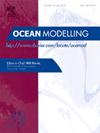Assessment and future projections of storm surge using CMIP6 models in the Indo-Pacific region
IF 2.9
3区 地球科学
Q2 METEOROLOGY & ATMOSPHERIC SCIENCES
引用次数: 0
Abstract
Storm surges are critical events for densely populated coastal areas and offshore islands, with the occurrence of coastal flooding expected to increase due to sea-level rise and intensified storm activity under climate change. This study evaluates projected changes in both seasonal mean and extreme storm surges across the Indo-Pacific region using high-resolution Coupled Model Intercomparison Project Phase 6 (CMIP6) climate models under the SSP5–8.5 high-emission scenario. This study assesses the seasonal storm surge simulation skill of five CMIP6 models, benchmarked against ERA5 reanalysis data for the period 1979–2010. The model performance is quantified with the comprehensive rating index (CRI) confirming that the Multi-Model Ensemble (MME) for the climate projections has the best overall performance. The Generalized Extreme Value (GEV) distribution, applied using the block maxima method, is used to estimate 100-year return values (RV100) for both the historical (1971–2000) and near-term (2021–2050) periods during the JJA (June–August) and SON (September–November) seasons. The RV100 analysis reveals heightened surge potential in the North Pacific, South China Sea, and the southern coasts of Australia and New Zealand, with a notable shift in surge intensity from the South China Sea to the North Pacific, particularly intensifying during SON. Projections indicate strong seasonal surge intensities, with the Yellow Sea, Gulf of Carpentaria, and the southern coasts of Australia and New Zealand regions showing pronounced increases in JJA, while positive changes in SON are evident in the North Pacific, North Indian Ocean (NIO), the Indonesian coast, and Gulf of Thailand, suggesting the potential for increased impact from extreme surges in these areas.
利用CMIP6模式对印度-太平洋地区风暴潮的评估和未来预测
风暴潮是人口密集的沿海地区和近海岛屿的关键事件,在气候变化的影响下,由于海平面上升和风暴活动加剧,预计沿海洪水的发生将增加。本研究利用高分辨率耦合模式比对项目第6阶段(CMIP6)气候模式评估了在SSP5-8.5高排放情景下印度太平洋地区季节平均和极端风暴潮的预估变化。本文以1979-2010年的ERA5再分析数据为基准,评估了5个CMIP6模式的季节性风暴潮模拟能力。用综合评级指数(CRI)对模式性能进行了量化,证实了多模式集合(MME)对气候预估的总体性能最好。采用块极大值法,利用广义极值(GEV)分布估计了JJA(6 - 8月)和SON(9 - 11月)季节的历史(1971-2000)和近期(2021-2050)期间的100年回归值(RV100)。RV100分析显示,北太平洋、南海以及澳大利亚和新西兰南部海岸的浪涌潜力增强,浪涌强度从南海向北太平洋明显转移,特别是在SON期间增强。预测显示,季节性浪涌强度较强,黄海、卡奔塔利亚湾以及澳大利亚和新西兰地区的南部海岸的JJA明显增加,而北太平洋、北印度洋(NIO)、印度尼西亚海岸和泰国湾的SON的积极变化很明显,表明这些地区极端浪涌的影响可能会增加。
本文章由计算机程序翻译,如有差异,请以英文原文为准。
求助全文
约1分钟内获得全文
求助全文
来源期刊

Ocean Modelling
地学-海洋学
CiteScore
5.50
自引率
9.40%
发文量
86
审稿时长
19.6 weeks
期刊介绍:
The main objective of Ocean Modelling is to provide rapid communication between those interested in ocean modelling, whether through direct observation, or through analytical, numerical or laboratory models, and including interactions between physical and biogeochemical or biological phenomena. Because of the intimate links between ocean and atmosphere, involvement of scientists interested in influences of either medium on the other is welcome. The journal has a wide scope and includes ocean-atmosphere interaction in various forms as well as pure ocean results. In addition to primary peer-reviewed papers, the journal provides review papers, preliminary communications, and discussions.
 求助内容:
求助内容: 应助结果提醒方式:
应助结果提醒方式:


